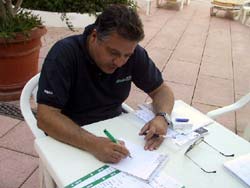| 45th GENERALI European Bridge Championships, Arona, Tenerife, Canary Islands | Wednesday, 27 June 2001 |
|
The Greeks have a natural feeling for card play By Svend Novrup Interview with Ioannis Damigos, npc, and Kostas Kapayannides, one of the players who seem to be headed for Bali after a convincing performance. Greece are on their way to the best result ever in their bridge history. Until now the best performance was winning the qualification group in the Venice Olympiad 1988 after which they lost the quarter-final to India. In the Europeans in Turku they came 4th but at that time that did not qualify for the Bermuda Bowl.
We are all amateurs who have to use our holiday for the bridge, we can not afford to go to bridge festivals, we do not get all expenses covered, and there could be no question of compensation for lost income. Our federation is small, we have just about 2,500 members, and we have a very small revenue from membership dues. We are a member of the Greek Sports Federation and receive a subsidy of around $65,000 per year (25 million drachmers). Kapayannides gets very excited here: If we qualify for Bali, I am sure that this will be a wonderful opportunity and be a great boost to bridge in Greece. The government will support us strongly, they usually do if a sport is suddenly a success. It seems that Damigos is not quite as optimistic but he hopes that Kapayannides is right. I ask how a federation with so few members can field such a strong team. 80% of the organised players in the country come from Athens, and the top players meet in all our top events which occupy around 12 weekends every year. We play rubber bridge, we discuss bridge, we read whatever books we can get hold of, and now we have the internet as well. In the months ahead of Tenerife we came together one extra day per week to practice our bidding or to play together with pairs we invited. We really try to inspire each other. It is a great advantage that the Greeks have a natural feeling for card games. That is why we think that we would have thousands of bridge players if we could get a foothold in the schools and Universities but most parents do not want their children to take up bridge as they still associate it with gambling. If bridge went Olympic or we qualify for Bali, this might help a lot. I remember the Europeans in Athens 1971 when there were very few players, most of them from the aristocracy of the country. One very idealistic friend I got on that occasion was Costas Kyriakos who was working with juniors and trying to spread the game to all social groups. Amazingly Damigos and Kapayannides know him very well: You know, we were both among his pupils. It was difficult for him as the Greek Federation had been founded only four years earlier and did not become a member of the Sports Federation until 1975. But since then the bridge interest has grown considerably. We have some juniors though at present they are not so strong, and we did not participate in the latest European Junior Championships but we will be back. In 1986 the European Junior Pairs was won by Thanos Kapayannides (his friends never call him Athanasios) and Liarakos, and as you see, they are in our team today. And when the Generali Individual event was played in Athens last year, a Greek player won the junior event. Asked about a good hand, Kapayannides presents this, round 21, Greece - Switzerland:
This is no brilliancy but it demonstrates how Kannavos thinks and analyses. Here he gave the bidding and the lead some thought and concluded: North did not make a negative double over 1ª so he probably has a maximum of three hearts. The lead (3rd and 5th highest) indicates five diamonds, and suddenly he realised that South had to be 4-4-3-2 since he had neither three clubs (he would have opened 1§) or five cards in a major. With this analysis in mind he quickly solved the problem of the hand which is to avoid more than two club losers. He won trick one with ªJ, played a heart to the ace and a low club from dummy to the ten and queen. He ruffed the diamond return and played a low club to §8 knowing that South now had the bare §A. The rest was trivial. When declarer failed at the other table, we gained 12 IMPs. | |||||||||||||||||||||||||||||||||||||||
|
Page 2 |

